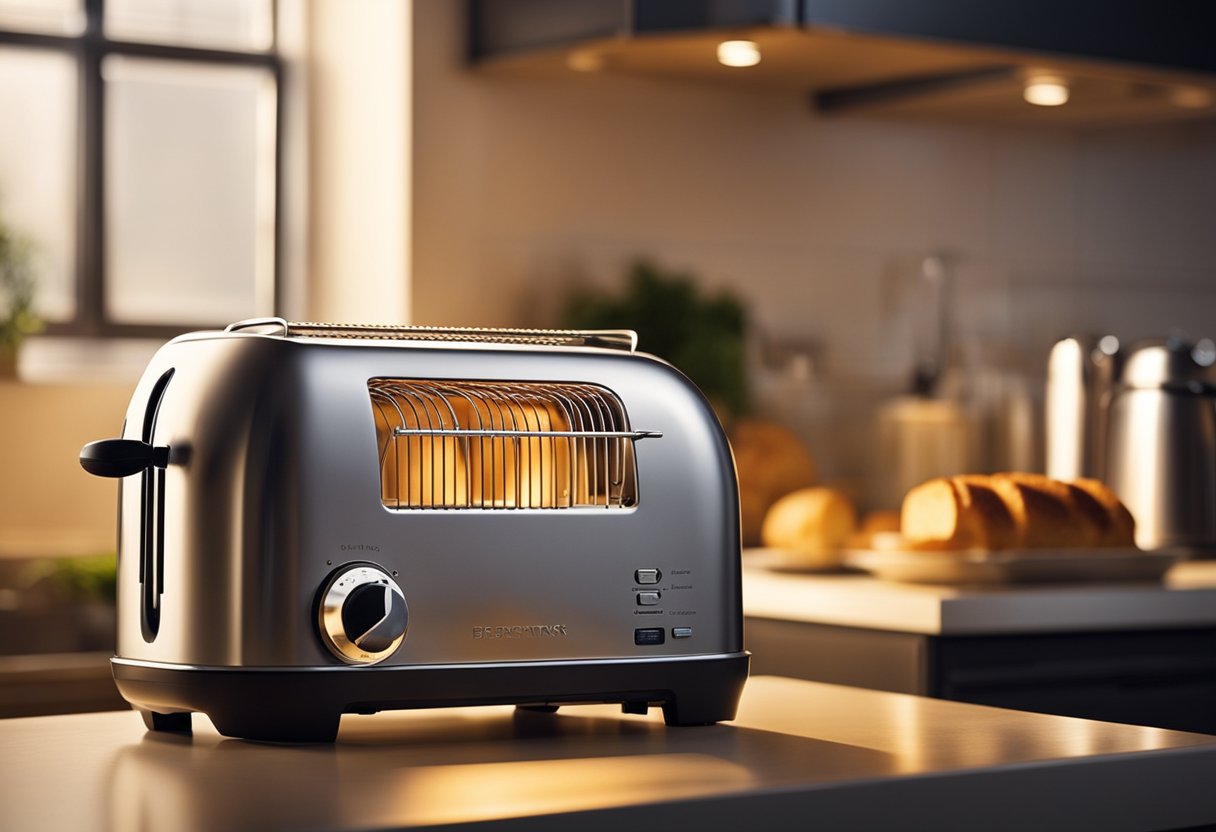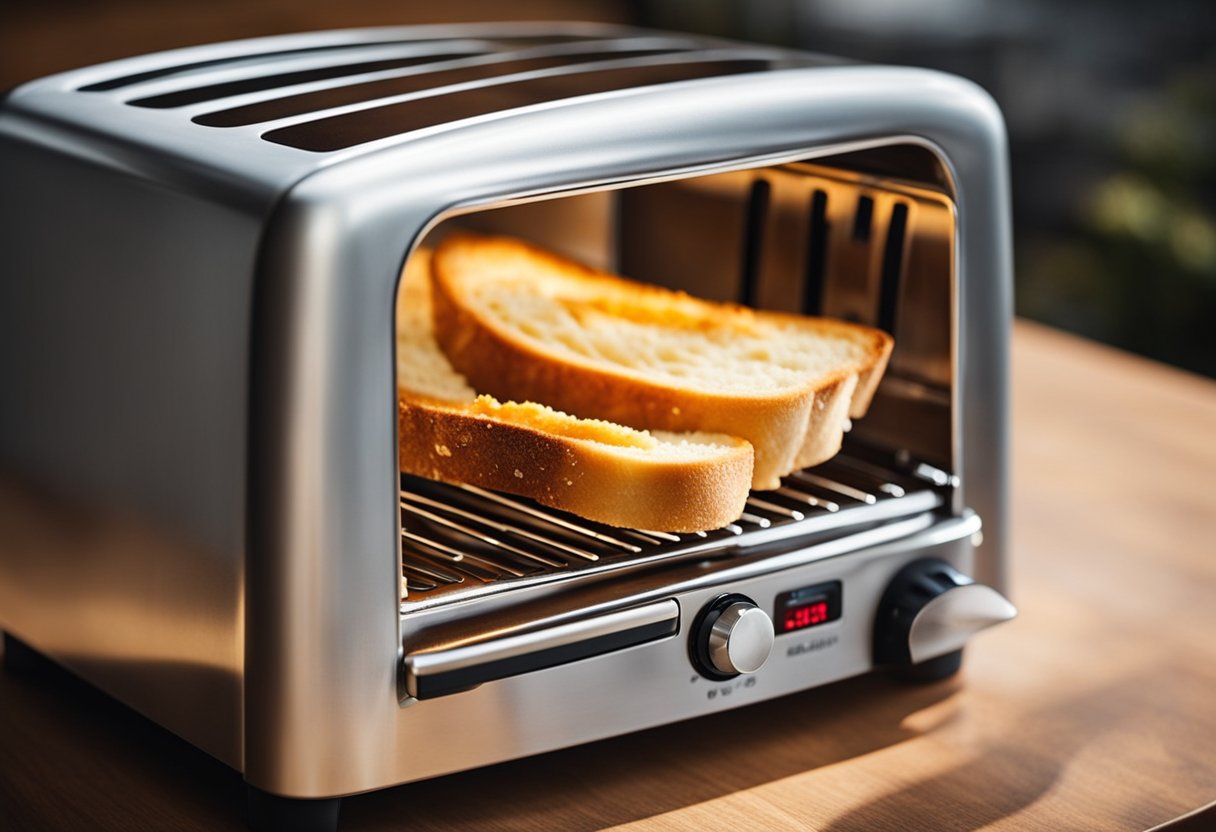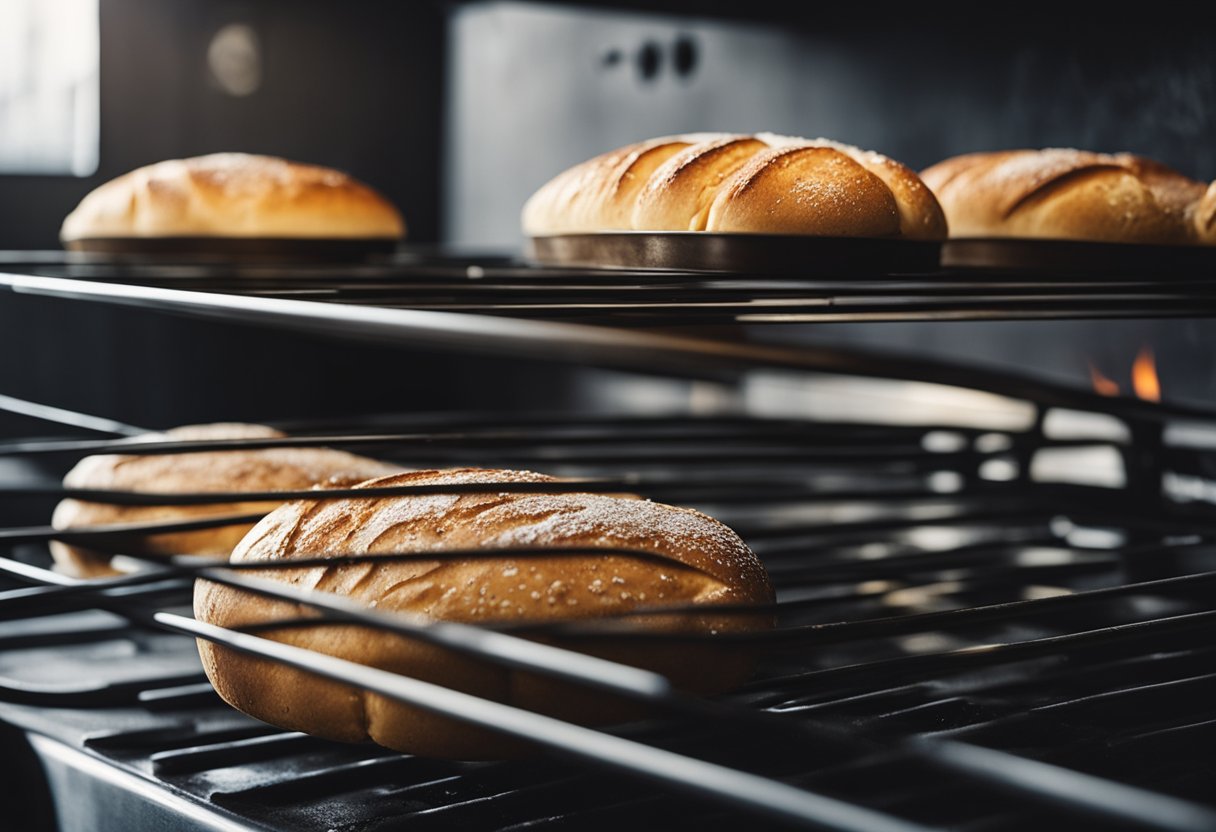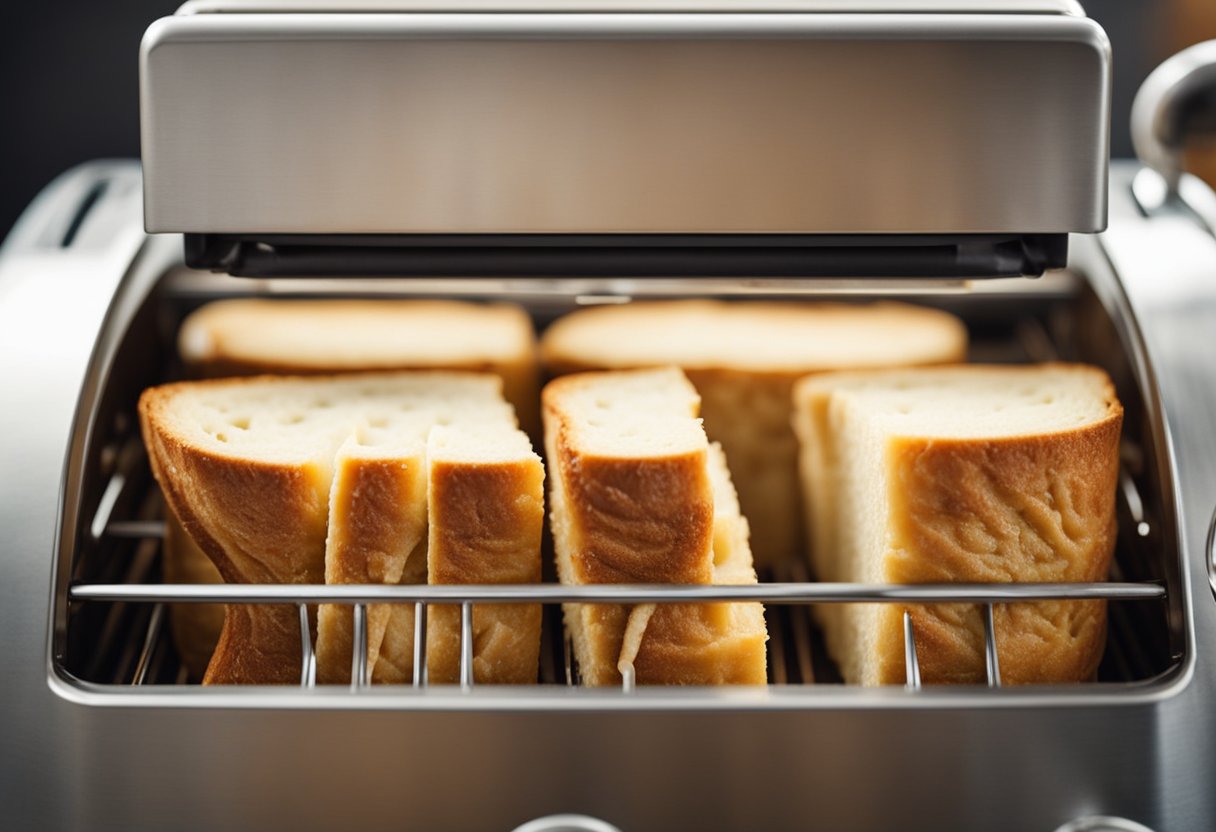As a bread lover, there’s nothing more disappointing than biting into a slice of reheated bread that’s hard, dry, and unappetizing.
Fortunately, there are several ways to reheat bread without making it hard. By understanding the nature of bread and the importance of temperature control, you can enjoy fresh, soft, and flavorful bread every time.

Bread is a delicate food that can easily dry out or become hard when reheated improperly.
Understanding the different types of bread and their unique characteristics is essential for reheating bread without making it hard.
Whether you’re dealing with hard or leftover bread, there are several tools and techniques you can use to maintain its softness and freshness.
Key Takeaways
- Understanding the nature of bread and the importance of temperature control is essential for reheating bread without making it hard.
- There are several tools and techniques you can use to maintain bread softness and freshness.
- By following the right methods, you can enjoy fresh, soft, and flavorful bread every time you reheat it.
Understanding the Nature of Bread

As a baking enthusiast, I know that bread is a staple food enjoyed by many around the world. Bread comes in different shapes, sizes, and flavors, and it is a versatile food that can be eaten with different meals.
However, when bread is not eaten fresh, it tends to become stale and hard, which can make it unappetizing. In this section, I will share some insights into the nature of bread and how it affects its texture, aroma, and softness.
Texture and Aroma
Bread has a unique texture and aroma that makes it appealing to many. The texture of bread is influenced by its ingredients, the baking process, and the moisture content. Freshly baked bread has a soft and chewy texture, while stale bread is hard and dry.
The aroma of bread is also affected by the baking process and the ingredients used. For instance, bread baked with herbs and spices has a more robust aroma than plain bread.
Softness and Crust
The softness of bread is determined by its moisture content. Freshly baked bread has a high moisture content, which makes it soft and chewy.
However, as the bread ages, it loses moisture, and its softness decreases. The crust of bread is also an essential factor that affects its texture.
The crust is formed during the baking process, and it protects the soft interior of the bread. The crust also adds flavor and texture to the bread.
Stale Bread and Freshness
Stale bread is a common problem that many people face. Stale bread is hard and dry, and it is unappetizing. Stale bread is caused by the loss of moisture and the breakdown of starch molecules.
Freshness is an essential factor that affects the texture and flavor of bread. Fresh bread has a soft and chewy texture, and it has a pleasant aroma.
To maintain the freshness of bread, it should be stored properly in a cool and dry place.
In summary, understanding the nature of bread is essential when it comes to reheating it without making it hard.
The texture, aroma, softness, crust, stale bread, and freshness are all factors that affect the quality of bread. By understanding these factors, you can reheat bread properly and enjoy it as if it was freshly baked.
Importance of Temperature Control
When it comes to reheating bread, temperature control is crucial. Reheating bread at too high of a temperature can cause it to become hard and dry, while reheating it at too low of a temperature can result in uneven heating and potentially unsafe consumption.
To ensure the best results, it is important to preheat the oven to the appropriate temperature before reheating the bread.
I recommend preheating the oven to 350°F, as this is the ideal temperature for most types of bread. Going any higher than this temperature will likely burn the bread, while going any lower will require a longer cooking time, resulting in very dry bread.
Another important aspect of temperature control is to cook the bread at a low temperature. Slow and low is the goal when reheating bread, as heating it up too quickly can cause it to become hard and dry.
Instead, try reheating it at a lower temperature over a longer period. For example, if you are using an oven, preheat it to around 300°F and then place the bread inside.
This will allow the bread to heat up gradually and evenly, resulting in a soft and delicious end product.
In addition to preheating the oven and cooking at a low temperature, it is also important to wrap the bread in aluminum foil before placing it in the oven.
This will help to prevent the bread from becoming too dry and will also ensure that it heats up evenly.
Overall, temperature control is key when it comes to reheating bread. By preheating the oven, cooking at a low temperature, and wrapping the bread in aluminum foil, you can ensure that your bread comes out soft and delicious every time.
Reheating Bread in the Oven
When it comes to reheating bread, the oven is a great option. It allows you to achieve a crispy crust and a soft interior without making the bread hard. Here’s how I do it:
- Preheat the oven to 350°F (175°C). This is the ideal temperature for reheating bread. Any hotter and the bread could burn quickly. A lower temperature would require a longer cooking time, resulting in dry bread.
- Wrap the bread in aluminum foil. This will help prevent the bread from drying out and will also keep it from getting too dark. Make sure the foil is tightly wrapped around the bread.
- Place the wrapped bread on a baking sheet and put it in the oven. Bake for about 10-15 minutes, depending on the size of the bread and how much you’re reheating. Check the bread after 10 minutes to see if it’s heated through. If not, put it back in the oven for a few more minutes.
- Remove the bread from the oven and unwrap it. If you want the crust to be crispy, you can leave it unwrapped for a few minutes. If you prefer a softer crust, wrap the bread back up in the foil.
- Enjoy your freshly reheated bread! It should be warm, soft, and golden brown.
Using aluminum foil to wrap the bread is essential to prevent it from drying out. The foil traps moisture and steam inside, which helps keep the bread soft and fresh.
Additionally, preheating the oven to the correct temperature is important to ensure the bread is reheated evenly and doesn’t burn.
Overall, reheating bread in the oven is a simple and effective method that yields great results. Just follow these steps, and you’ll have warm, delicious bread in no time!
Using the Microwave for Reheating
When it comes to reheating bread, the microwave can be a quick and easy option. However, it’s important to know how to use it properly to avoid ending up with hard, chewy bread. Here’s how I do it:
- Start by placing the bread on a microwave-safe plate. Make sure the plate is big enough to hold the bread without it hanging over the edges.
- To prevent the bread from drying out, place a damp paper towel over it. This will help to add moisture and keep the bread soft.
- Set the microwave to 30-40% power, depending on your microwave’s settings. This will prevent the bread from overheating and becoming hard.
- Microwave the bread in short bursts of 20-30 seconds. Check the bread after each interval to see if it’s warm enough. Repeat until it’s heated to your desired temperature.
- Once the bread is heated, remove it from the microwave and discard the damp paper towel. Be careful not to burn yourself, as the plate may be hot.
It’s important to note that not all breads are created equal, and some may not reheat well in the microwave. For example, crusty breads like baguettes or ciabatta may become chewy when reheated in the microwave.
In these cases, it may be better to use an oven or toaster oven to reheat the bread.
Overall, reheating bread in the microwave can be a quick and easy option, as long as you follow these simple steps to keep your bread soft and delicious.
Reheating Bread in an Air Fryer
I love using my air fryer to reheat bread because it’s quick, easy, and doesn’t leave the bread hard or dry. Here are a few simple steps to follow when reheating bread in an air fryer:
- Preheat the air fryer to 350°F. Depending on the model of the air fryer you have, preheating may vary. Some air fryers have a preheating feature, while others don’t. For best results, preheat your air fryer to 350°F before placing the bread inside.
- Place the bread in the air fryer basket. Make sure not to overcrowd the basket, as that can affect the airflow and even reheating. If your air fryer has multiple racks, you can use them to reheat more slices at once.
- Reheat the bread for 3-5 minutes. Check the bread after 3 minutes to see if it’s golden brown and crispy. If it’s not, continue reheating for another 1-2 minutes.
- Enjoy your warm, crispy, and fluffy bread! Serve it with your favorite toppings or use it as a base for sandwiches.
One of the great things about using an air fryer to reheat bread is that it doesn’t dry out the bread like a microwave can. The hot air circulates around the bread, making it crispy on the outside while keeping it soft and fluffy on the inside.
Overall, reheating bread in an air fryer is a great way to bring stale or leftover bread back to life. It’s quick, easy, and produces great results every time.
Reheating Bread on the Stove

When it comes to reheating bread, using the stove is a great option. It’s quick, easy, and doesn’t require any special equipment. Here’s how I do it:
- First, I slice the bread into pieces that are about 1/2 inch thick. This helps the bread heat up more evenly.
- Next, I heat up a non-stick pan on low heat. It’s important to use low heat to prevent the bread from burning.
- Once the pan is hot, I add a small amount of butter. This helps the bread get crispy and adds some flavor. I usually use about 1/2 tablespoon of butter per slice of bread.
- Once the butter has melted, I add the bread to the pan. I make sure to space the slices out so that they’re not touching.
- I let the bread cook for about 1-2 minutes on each side, or until it’s heated through and crispy on the outside. If the bread is particularly thick, I might need to cook it for a little longer.
That’s it! Reheating bread on the stove is really that simple. It’s a great way to revive leftover bread and make it taste fresh again. Just remember to use low heat and a little bit of butter for the best results.
Reheating Bread Using a Steamer
When it comes to reheating bread, using a steamer is one of the best methods to ensure that the bread stays moist and doesn’t become hard.
Steaming bread is an excellent way to add moisture back into the bread while reheating it.
To use a steamer to reheat bread, simply follow these steps:
- Fill the steamer with water and turn it on to heat the water.
- Wrap the bread in a damp towel or cloth to keep it moist.
- Place the wrapped bread in the steamer basket or on the steamer tray.
- Cover the steamer with a lid.
- Steam the bread for 5-10 minutes, depending on the size and thickness of the bread.
The steam will add moisture back into the bread, making it soft and delicious again. The damp towel or cloth will also help to keep the bread from drying out while it is being reheated.
It’s important to note that when using a steamer to reheat bread, you want to make sure that the bread doesn’t get too wet. If the bread gets too wet, it can become soggy and lose its texture.
Overall, reheating bread using a steamer is a great way to ensure that your bread stays moist and delicious. It’s a simple and easy method that anyone can use to reheat their bread without making it hard.
Freezing and Thawing Bread
When it comes to reheating bread, the first step is often to freeze it. Freezing bread is a great way to extend its shelf life and ensure that you always have fresh bread on hand.
However, it’s important to freeze bread properly to avoid making it hard when reheating. Here are some tips for freezing and thawing bread:
Freezing Bread
To freeze bread, start by slicing it into individual slices. This will make it easier to thaw and reheat later. Once sliced, place the bread in a plastic bag and seal it tightly.
Be sure to remove as much air from the bag as possible to prevent freezer burn.
When freezing bread, it’s important to do it at the right time. Ideally, you should freeze bread when it’s fresh. This will ensure that it retains its flavor and texture when reheated.
If you wait too long to freeze bread, it may become dry and hard when reheated.
Thawing Bread
When it’s time to reheat your frozen bread, the first step is to thaw it. To thaw bread, remove it from the freezer and let it sit at room temperature for several hours. This will allow it to thaw slowly and evenly.
It’s important to avoid thawing bread in the microwave or oven, as this can cause it to become hard and dry. Instead, let it thaw naturally at room temperature.
thawed, you can proceed with reheating it using one of the methods outlined in the previous section.
In summary, freezing and thawing bread is a great way to extend its shelf life and ensure that you always have fresh bread on hand.
To freeze bread properly, slice it into individual slices, place it in a plastic bag, and remove as much air as possible. When it’s time to reheat, be sure to thaw it slowly at room temperature to avoid making it hard.
Maintaining Bread Softness and Freshness
When reheating bread, the goal is to maintain its softness and freshness. Here are some tips on how to achieve this:
- Use a damp paper towel: Placing a damp paper towel over the bread before reheating it can help retain moisture and prevent it from drying out. This works well for sliced bread or rolls that are already baked.
- Add moisture: Adding moisture to the reheating process can also help maintain softness and freshness. One way to do this is to sprinkle some water on the bread before reheating it. Another option is to place a small dish of water in the oven while the bread is reheating.
- Wrap soft bread: If you have soft bread like a baguette or ciabatta, wrap it in foil before reheating. This will help trap moisture and prevent the crust from getting too hard.
- Store bread properly: Proper storage is key to maintaining bread softness and freshness. Bread should be stored in a cool, dry place away from direct sunlight. A bread box or a plastic bag can also help retain moisture.
By following these tips, you can reheat bread without making it hard and maintain its softness and freshness.
Understanding Different Bread Types

As someone who loves bread, I know that different types of bread require different reheating methods. Here are some common bread types and the best ways to reheat them without making them hard:
Baguette
Baguettes are long and thin French bread loaves that have a crispy crust and a soft interior. To reheat a baguette, preheat your oven to 350°F, wrap the bread in foil, and bake it for about 10 minutes.
This will help the bread retain its crustiness while warming the interior.
Garlic Bread
Garlic bread is a delicious side dish that is made by spreading garlic butter on slices of bread and toasting them.
To reheat garlic bread, wrap the slices in foil and bake them in the oven at 350°F for about 5-7 minutes. This will help the garlic butter melt and the bread become warm and crispy.
French Bread
French bread is a crusty bread that has a chewy interior. To reheat French bread, preheat your oven to 350°F, wrap the bread in foil, and bake it for about 10 minutes.
This will help the bread retain its crustiness while warming the interior.
Dinner Rolls
Dinner rolls are small, round bread rolls that are often served at dinner parties or holiday meals.
To reheat dinner rolls, preheat your oven to 350°F, wrap the rolls in foil, and bake them for about 5-7 minutes. This will help the rolls become warm and soft again.
Toast
Toast is bread that has been sliced and toasted until it is crispy. To reheat toast, place it in a toaster or toaster oven and heat it until it is warm and crispy again.
Overall, the best way to reheat bread without making it hard is to use an oven or toaster oven and wrap the bread in foil. This will help the bread retain its moisture and prevent it from drying out.
Dealing with Hard or Leftover Bread
As a bread lover, I know how frustrating it can be to end up with rock-hard or stale bread. But don’t worry, I’ve got some tips to help you deal with hard or leftover bread and turn it into something delicious.
Make Croutons
One of the easiest ways to use up leftover bread is to turn it into croutons. Simply cut the bread into small cubes, toss them with some olive oil and your favorite seasonings, and bake them in the oven until they’re crispy and golden brown.
Croutons are great for adding crunch to salads, soups, and stews.
Reheat with Water
If you want to reheat bread without making it hard, try using water. This is a fool-proof method that works for all types of bread, from baguettes to rolls.
Simply sprinkle some water over the bread, wrap it in aluminum foil, and pop it in the oven for a few minutes. The steam from the water will help to revive the bread and make it soft and fluffy again.
Make Bread Pudding
Another great way to use up leftover bread is to turn it into bread pudding. This classic dessert is made by soaking stale bread in a mixture of eggs, milk, and sugar, and baking it until it’s golden brown and crispy on top.
You can add your favorite flavors and ingredients to the mix, such as cinnamon, vanilla, chocolate chips, or raisins.
Freeze for Later
If you have leftover bread that you can’t use up right away, don’t throw it away. Instead, freeze it for later use. Simply wrap the bread in plastic wrap or aluminum foil, and put it in the freezer.
When you’re ready to use it, just thaw it out at room temperature or in the microwave, and it will be good as new.
In conclusion, there are many ways to deal with hard or leftover bread. Whether you make croutons, reheat with water, make bread pudding, or freeze for later, you can turn your stale bread into something delicious and avoid food waste.
Tools and Techniques for Reheating Bread
When it comes to reheating bread, there are several tools and techniques you can use to make sure it stays soft and fluffy. Here are some of the most popular methods:
Toaster
Using a toaster is one of the quickest and easiest ways to reheat bread. Simply place the bread in the toaster and set it to the desired level of toasting. Keep an eye on the bread to make sure it doesn’t burn.
Toaster Oven
A toaster oven is another great option for reheating bread. Preheat the toaster oven to 350°F and place the bread on the rack. Heat for 5-10 minutes or until the bread is warm and soft.
Brown Paper Bag
If you don’t have a toaster or toaster oven, you can use a brown paper bag to reheat bread. Place the bread in the bag and fold the top over to seal it.
Put the bag in the oven at 350°F for 10 minutes. This method creates steam, which helps to keep the bread soft and moist.
Microwave
While the microwave is a quick and convenient way to reheat bread, it can also make the bread hard and chewy if not done correctly.
To avoid this, wrap the bread in a damp paper towel and microwave it on high for 10-15 seconds. Check the bread to see if it’s warm enough, and repeat if necessary.
Stovetop
If you have a gas stove, you can use it to reheat bread. Turn the burner on low and place the bread directly on the grate. Heat for a few minutes on each side until the bread is warm and soft.
Overall, there are several tools and techniques you can use to reheat bread without making it hard. Whether you prefer a toaster, toaster oven, brown paper bag, microwave, or stovetop, each method has its own advantages and disadvantages.
Experiment with different methods to find the one that works best for you.
Frequently Asked Questions
How can I reheat bread without making it hard?
To reheat bread without making it hard, you can use an oven, microwave, or stovetop. The key is to avoid overheating the bread, which can cause it to become dry and tough.
Instead, reheat the bread slowly and at a low temperature, covering it with a damp paper towel or cloth to prevent it from drying out.
What are some tips for reheating bread from the fridge?
When reheating bread from the fridge, it’s important to bring it to room temperature first. This helps prevent the bread from becoming soggy or unevenly heated.
You can do this by leaving the bread out on the counter for 10-15 minutes before reheating it in the oven or toaster. Another tip is to wrap the bread in foil or place it in a covered dish to help retain moisture.
What is the best way to reheat crusty bread?
To reheat crusty bread, the best method is to use an oven. Preheat the oven to 350°F, then wrap the bread in foil and place it on a baking sheet. Bake for 10-15 minutes, or until the bread is heated through.
If you prefer a crispy crust, remove the foil for the last few minutes of baking.
How can I heat bread in the oven without using foil?
To heat bread in the oven without using foil, you can place it on a baking stone or directly on the oven rack. This method allows the bread to heat evenly and develop a crispy crust.
If you’re worried about the bread sticking to the oven rack, you can place a sheet of parchment paper underneath it.
What is the recommended time for reheating bread in the oven?
The recommended time for reheating bread in the oven varies depending on the type of bread and the desired level of warmth.
As a general rule, it’s best to reheat bread at a low temperature for a longer period of time to avoid drying it out. For most bread, a temperature of 350°F and a reheating time of 10-15 minutes should be sufficient.
What is the best way to reheat frozen bread in the oven?
To reheat frozen bread in the oven, first thaw it at room temperature for a few hours or overnight in the fridge. Once thawed, preheat the oven to 350°F and wrap the bread in foil.
Bake for 10-15 minutes, or until the bread is heated through. For a crispy crust, remove the foil for the last few minutes of baking.







